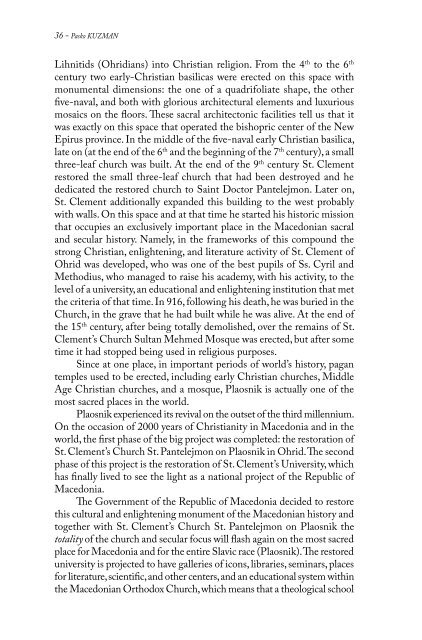CULTURAL HERITAGE: - Macedonian Information Centre
CULTURAL HERITAGE: - Macedonian Information Centre
CULTURAL HERITAGE: - Macedonian Information Centre
You also want an ePaper? Increase the reach of your titles
YUMPU automatically turns print PDFs into web optimized ePapers that Google loves.
3 - Pasko kuzMan<br />
Lihnitids (Ohridians) into Christian religion. From the 4 th to the 6 th<br />
century two early-Christian basilicas were erected on this space with<br />
monumental dimensions: the one of a quadrifoliate shape, the other<br />
five-naval, and both with glorious architectural elements and luxurious<br />
mosaics on the floors. These sacral architectonic facilities tell us that it<br />
was exactly on this space that operated the bishopric center of the New<br />
Epirus province. In the middle of the five-naval early Christian basilica,<br />
late on (at the end of the 6 th and the beginning of the 7 th century), a small<br />
three-leaf church was built. At the end of the 9 th century St. Clement<br />
restored the small three-leaf church that had been destroyed and he<br />
dedicated the restored church to Saint Doctor Pantelejmon. Later on,<br />
St. Clement additionally expanded this building to the west probably<br />
with walls. On this space and at that time he started his historic mission<br />
that occupies an exclusively important place in the <strong>Macedonian</strong> sacral<br />
and secular history. Namely, in the frameworks of this compound the<br />
strong Christian, enlightening, and literature activity of St. Clement of<br />
Ohrid was developed, who was one of the best pupils of Ss. Cyril and<br />
Methodius, who managed to raise his academy, with his activity, to the<br />
level of a university, an educational and enlightening institution that met<br />
the criteria of that time. In 916, following his death, he was buried in the<br />
Church, in the grave that he had built while he was alive. At the end of<br />
the 15 th century, after being totally demolished, over the remains of St.<br />
Clement’s Church Sultan Mehmed Mosque was erected, but after some<br />
time it had stopped being used in religious purposes.<br />
Since at one place, in important periods of world’s history, pagan<br />
temples used to be erected, including early Christian churches, Middle<br />
Age Christian churches, and a mosque, Plaosnik is actually one of the<br />
most sacred places in the world.<br />
Plaosnik experienced its revival on the outset of the third millennium.<br />
On the occasion of 2000 years of Christianity in Macedonia and in the<br />
world, the first phase of the big project was completed: the restoration of<br />
St. Clement’s Church St. Pantelejmon on Plaosnik in Ohrid. The second<br />
phase of this project is the restoration of St. Clement’s University, which<br />
has finally lived to see the light as a national project of the Republic of<br />
Macedonia.<br />
The Government of the Republic of Macedonia decided to restore<br />
this cultural and enlightening monument of the <strong>Macedonian</strong> history and<br />
together with St. Clement’s Church St. Pantelejmon on Plaosnik the<br />
totality of the church and secular focus will flash again on the most sacred<br />
place for Macedonia and for the entire Slavic race (Plaosnik). The restored<br />
university is projected to have galleries of icons, libraries, seminars, places<br />
for literature, scientific, and other centers, and an educational system within<br />
the <strong>Macedonian</strong> Orthodox Church, which means that a theological school


